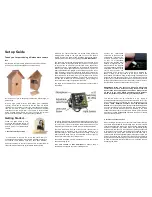
Falcon 4M Camera Manual
03-032-20044-01
DALSA
18
!
Input Signals, Camera Link
The camera accepts control inputs through the Camera Link MDR26F connector.
The camera ships in internal sync, internal programmed integration (exposure mode 2),
and Camera Link mode 16 (4M60) or 3 (4M30).
EXSYNC
Frame rate can be programmed using the serial interface. The external control signal
EXSYNC is optional and enabled through the serial interface. This camera uses the
falling
edge of EXSYNC
to trigger frame readout. Section 3.3 Camera Output Format details
how to set frame times, exposure times, and camera modes.
Output Signals, Camera Link
These signals indicate when data is valid, allowing you to clock the data from the camera
to your acquisition system. These signals are part of the Camera Link configuration and
you should refer to the DALSA Camera Link Implementation Road Map, available at
http://mv.dalsa.com/
, for the standard location of these signals.
Clocking Signal
Indicates
LVAL (high)
Outputting valid line
DVAL (high)
Valid data
STROBE (rising edge)
Valid data
FVAL (high)
Outputting valid frame
•
The camera internally digitizes to 10 bits and outputs 8 MSB or all 10 bits depending
on the camera’s Camera Link operating mode.
•
For a Camera Link reference and timing definitions refer to Appendix A on page 68.
2.2.3 Power Connector
Figure 8: Hirose 6-pin Circular Male—Power Connector
Hirose 6-pin Circular Male
5
4
6
2
3
1
Mat ing Par t: HIRO SE
HR10A-7P-6S
The camera requires a single voltage input (12 to 15V).
WARNING: When setting up the camera’s power supplies follow these guidelines:
•
Protect the camera with a
fast-blow fuse
between power supply and camera.
•
Power surge limit at 3 A.
•
12 V power supply. Nominal 0.85 A load resulting in ~20 A/s current ramp rate
•
Power supply current limit needs to be set at >3 A.
Hirose Pin Description
Pin Description Pin
Description
1
12 to 15V
4
GND
2
12 to 15V
5
GND
3
12 to 15V
6
GND
IMPORTANT:
Camera readout is
triggered on the falling
edge of EXSYNC.
















































